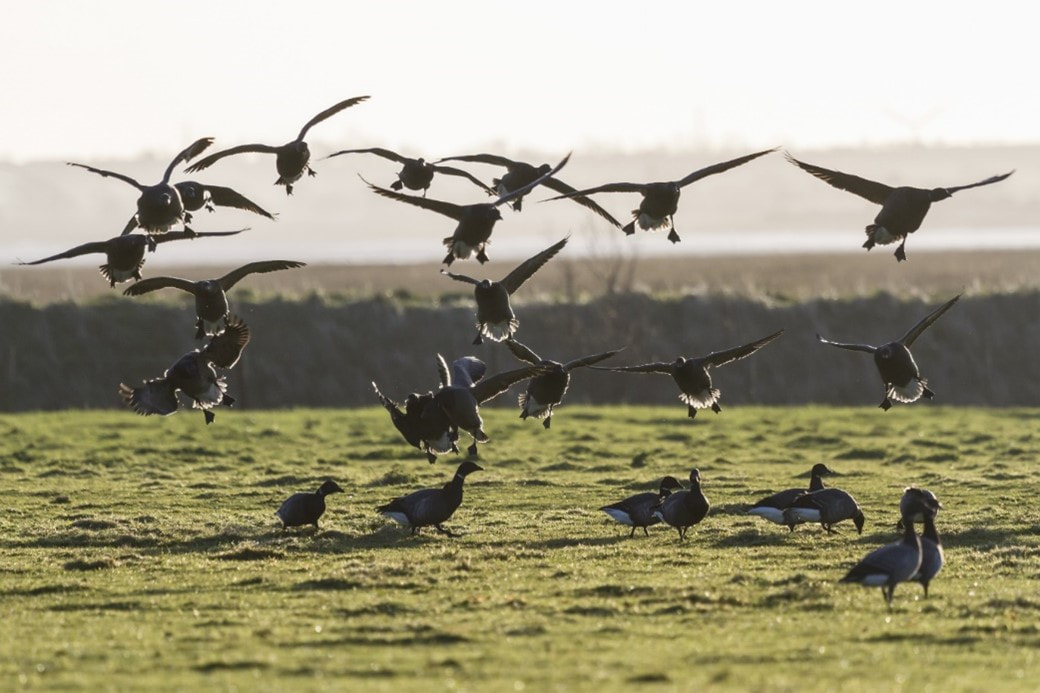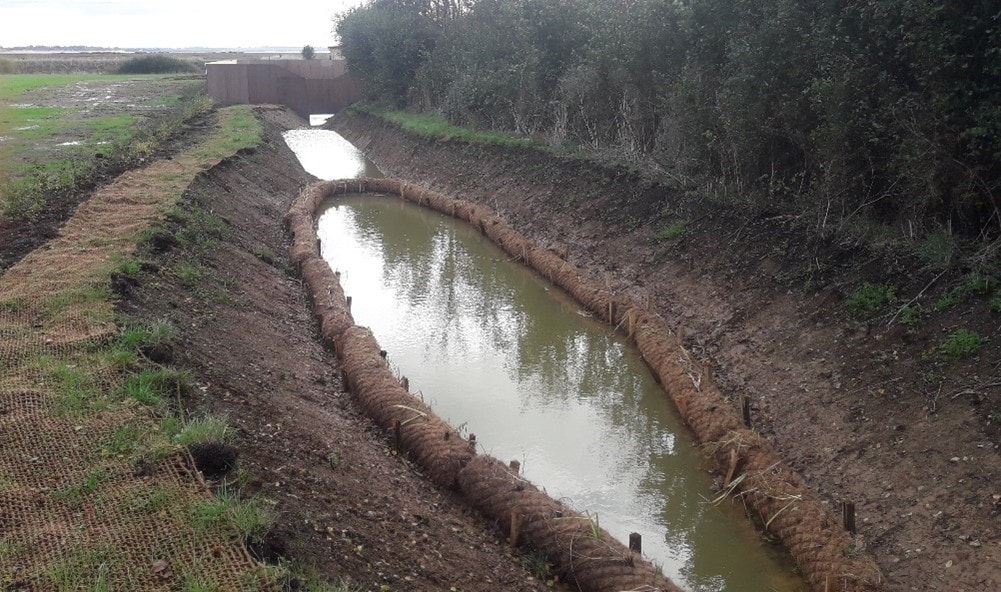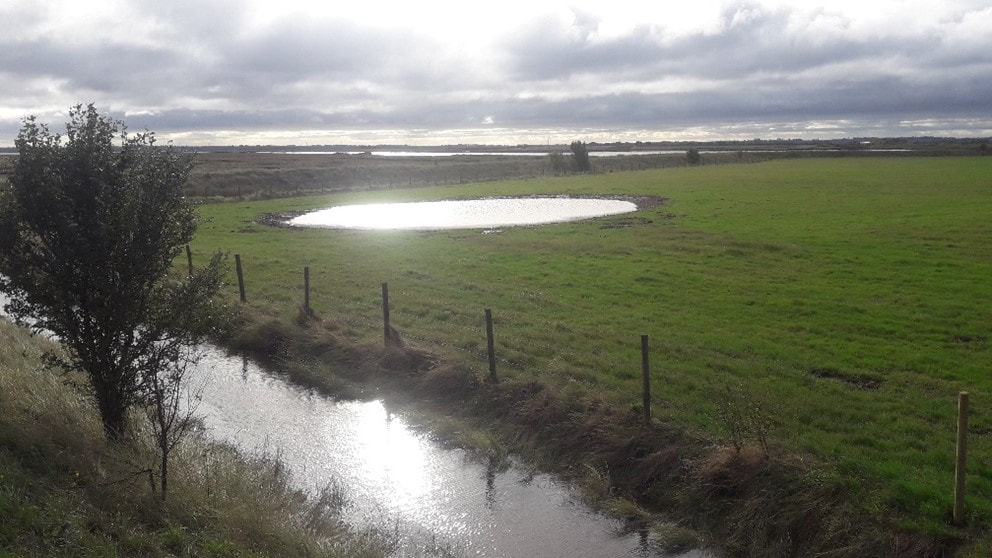|
Blog by David Mason, National Trust Ranger - Suffolk and Essex Coast ‘Increasing the extent and health of the saltmarsh area improves biodiversity and provides a range of other ‘ecosystem services’ (things that saltmarsh delivers for society) such as natural flood allevation, reductions in wave energy, spawning and nurseries for fish, providing food and shelter for birds, and locking up carbon dioxide to reduce the effects of climate change.’ I write this, the first Ranger’s blog from the Northey LOTE project, after visiting Northey Island on the Blackwater Estuary on the Essex coast. It was a bright November afternoon on a falling tide and as I approached the tidal causeway that links it to the mainland the last Lapwing and Dunlin were leaving the causeway to feed on the newly exposed mud. In the distance a flock of Golden Plover were glowing in the sunlight, reflected in the glistening mudflats. This is a spectacular place to see coastal birds when large flocks of waders and wildfowl gather on the estuary to feed and roost. Several years ago, I saw c.5000 Brent Geese land on a site on the Suffolk coast during an October storm as they came in to land for shelter, skein after skein, on their migration South. They left the next morning when the weather cleared and I wondered if I had dreamed it! I had heard that the Blackwater Estuary was a hotspot for them and have been delighted since starting work on the Essex coast last November to see where they were heading: Northey is a refuge for them in the winter where they roost and graze on the grass fields and on the saltmarsh as the tide comes up. In February I spent a happy morning clearing a footpath for the new circular visitor route we put in place this year, working with hand tools to minimise disturbance, while the geese chattered quietly in the field nearby. I first visited the site in 2019 as the work to realign the South Embankment was being undertaken. This work was finally completed this year after delay in 2020. The mud from the embankment was placed in the ditch behind it (from where it had originally been dug in the mid-1800’s) to reform the natural landscape; the realigned area has now been naturally colonised by a wide range of saltmarsh species such as sea purslane, samphire, sea aster and sea beet as the tide has flooded the area, bringing in seed from the surrounding area. This area grades into a rising grassland bank which as sea levels rise will become new saltmarsh but now provides a rare transitional area between the saltmarsh and terrestrial grassland. Now the pressure of coastal squeeze has been reduced, it is also notable that the saltmarsh in front of where the embankment was (which was heavily eroded) is also showing some signs of recovery with sediment depositing and new saltmarsh vegetation growing. I am impressed at how quickly this has established from bare mud. Allowing the coastal processes to function naturally without the constraints of man-made structures seems to be key. There is an increasing urgency to carry out more of this work for nature conservation as existing saltmarsh is rapidly eroding due to sea level rise and coastal squeeze on saltmarsh between the tide and coastal defences. The island has been busy with contractors this year and new habitat and visitor facilities have been created and installed in preparation for future realignment of other embankments. Volunteers from the Essex and Suffolk National Trust group helped in maintaining the visitor route and picked up eight bags of litter from the foreshore. There are a small number of water voles that live a marginal existence on Northey Island. The water voles’ homes and their numbers here have recently suffered from flooding from the sea (such as in 2013 and 2017/18) and hot dry summers. Part of our work in adapting to climate change and sea level rise is to create a new watery habitat for them. A new pond and ditch system has been created on higher ground which will provide a safer, more sustainable future home for Water Vole. Coir rolls with pond plants embedded have been placed which it is hoped will provide food and shelter for the voles and other wildlife when they become established. This is overlooked by a new hide where visitors will be able to look over the pond, a new scrape and establishing saltmarsh. A new scrape created this summer has filled with water and is already attracting Lapwing, Teal and Curlew amongst others. In some areas dredged sediment from elsewhere in the estuary is being used to increase the resilience of the marsh. The adaptation of the coastal processes this achieves will prevent further erosion of saltmarsh in these areas. Eroded creeks that were bare mud a few years ago are already building up with natural silt deposited by the tide and recolonising with saltmarsh plants. The estuary side of the bank in this area includes some areas of shingle which provide another niche habitat and attracted 49 Ringed Plover in August, as noted on the regular bird (WeBS) count.
All in all it has been a fascinating year seeing the work progress and habitats develop and sharing it with visitors and volunteers and now you.
0 Comments
Leave a Reply. |
Archives
April 2024
Categories
All
Photo credits: Oystercatcher by Katie Nethercoat (rspb-images.com)
LOTE Logo credits: Saskia Wischnewski |




